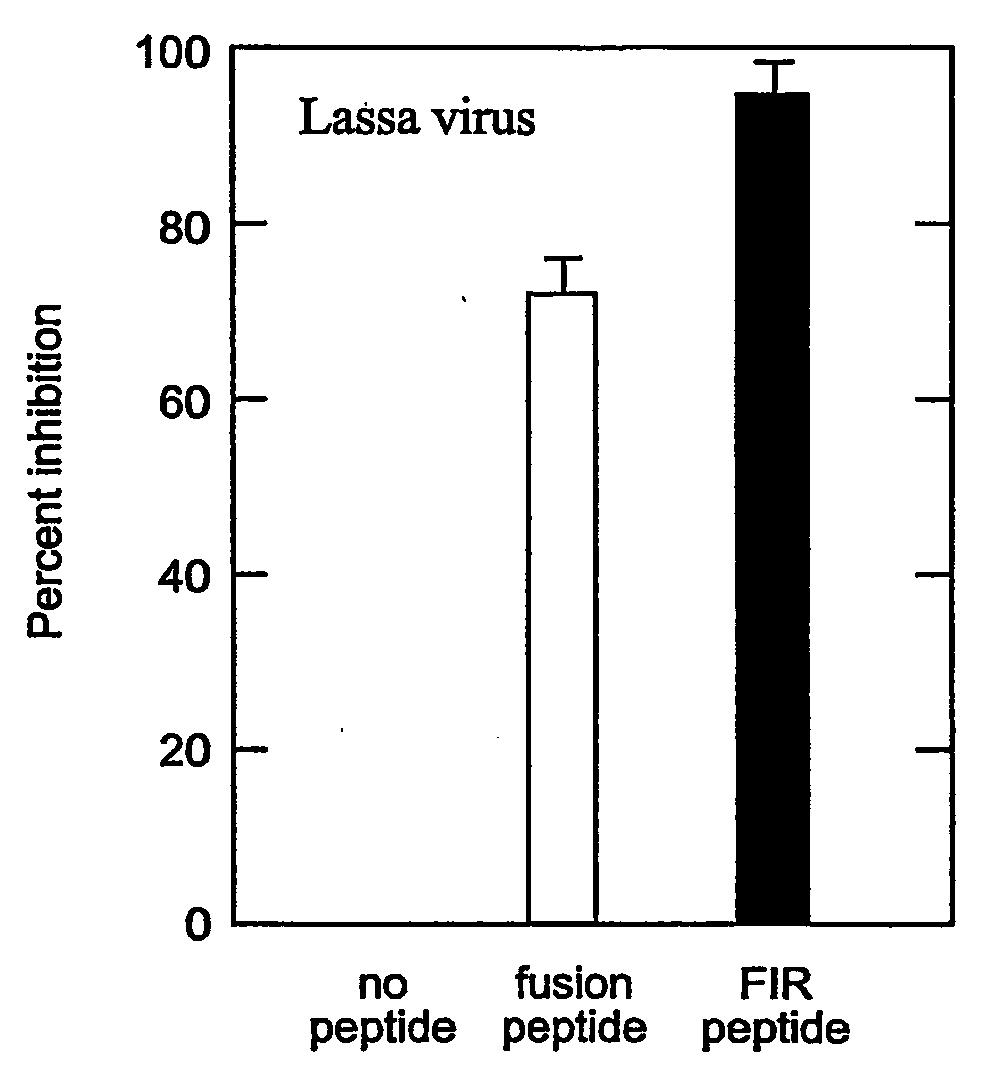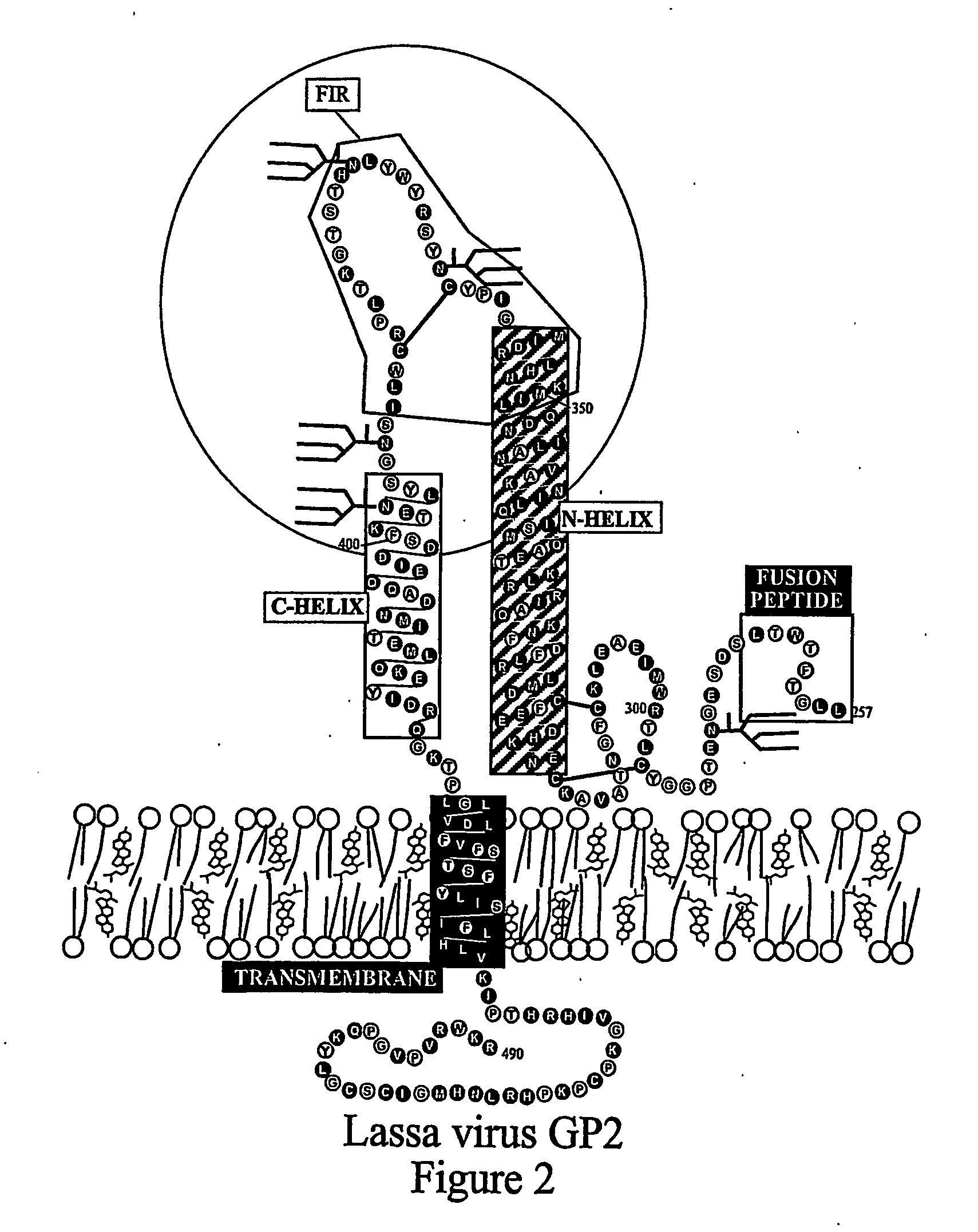Method of preventing virus: cell fusion by inhibiting the function of the fusion initiation region in rna viruses having class i membrane fusogenic envelope proteins
a technology of fusogenic envelope protein and cell fusion, which is applied in the field of preventing virus by inhibiting the function of the fusion initiation region of the rna virus having class i membrane fusogenic envelope protein, can solve the problems of not explaining the mechanism through which the inhibition occurs, and achieve the effect of preventing and/or inhibiting infection
- Summary
- Abstract
- Description
- Claims
- Application Information
AI Technical Summary
Benefits of technology
Problems solved by technology
Method used
Image
Examples
example 1
Identification of the FIR in Ebola virus
[0081] The method to identify the FIR of Class I viral fusion proteins can be illustrated by two examples. The first example is identification of the FIR in the minimal class I fusion protein glycoprotein 2 (GP2) of Ebola virus, a filovirus. The boundaries of the N-helix and the C-helix of Ebola virus GP2 have been determined by x-ray crystallographic methods (Malashkevich et al., 1999). The terminal amino acids of the N-helix contain the sequence ILNRKAIDF (SEQ ID NO:8) that fits the consensus of a core comprising three or four hydrophobic amino acids, a positively-charged amino acid, a negatively-charged amino acid, and an aromatic amino acid. Between these two helices are two cysteines in the sequence CHILGPDC (SEQ ID NO:9). Defining the ends of the Ebola virus GP2 FIR is the sequence FLLQRWGGTCHILGPDCCI (SEQ ID NO:10), which has a Wimley-White interfacial hydrophobicity score of 2.59 as determined by the MPEX program (Jaysinghe et al, 200...
example 2
Identification of the FIR in Measles Virus
[0082] The second example is a complex class I fusion protein, the F1 protein of measles virus, a paramyxovirus. The N- and C- helices of measles virus F1 can be identified by examining the primary sequence for amino acids with the propensity to form helices. Alignment of the primary sequence of measles virus F1 with the primary amino acid sequence of the F1 protein of another paramyxovirus, Newcastle disease virus F1, can also aid in the identification of the helix boundaries. The structure of the Newcastle disease virus F1 protein has been determined by x-ray crystallographic methods (Chen et al., 2001). The boundaries of the N- and C- helices can thus be predicted to be amino acids 131-217 and 455-491 respectively. In contrast to Ebola virus GP2 and most other viral class I fusion proteins, the primary sequence between the N- and C- helices in the measles virus is longer than 100 amino acids. The FIR region of measles virus F1 contains a...
example 3
Identification Of Coronavirus Fusion Inhibitory Peptides
Background
[0083] Severe acute respiratory syndrome (SARS) is a newly recognized illness that spread from southern China in late 2002 / early 2003 to several countries in Asia, Europe and North America (Guan et al., 2004). SARS usually begins with a fever greater than 38° C. Initial symptoms can also include headache, malaise and mild respiratory symptoms. Within two days to a week, SARS patients may develop a dry cough and have trouble breathing. Patients in more advanced stages of SARS develop either pneumonia or respiratory distress syndrome. In the initial outbreak there were 8098 cases worldwide, with an overall mortality of 9.6%. A previously unrecognized coronavirus (CoV) has been demonstrated to be the cause of the new disease (Poutanen et al., 2003; Peiris et al., 2003; Drosten et al., 2003; Rota et al., 2003; Mara et al., 2003). Public health interventions, such as surveillance, travel restrictions and quarantines, co...
PUM
 Login to View More
Login to View More Abstract
Description
Claims
Application Information
 Login to View More
Login to View More - R&D
- Intellectual Property
- Life Sciences
- Materials
- Tech Scout
- Unparalleled Data Quality
- Higher Quality Content
- 60% Fewer Hallucinations
Browse by: Latest US Patents, China's latest patents, Technical Efficacy Thesaurus, Application Domain, Technology Topic, Popular Technical Reports.
© 2025 PatSnap. All rights reserved.Legal|Privacy policy|Modern Slavery Act Transparency Statement|Sitemap|About US| Contact US: help@patsnap.com



